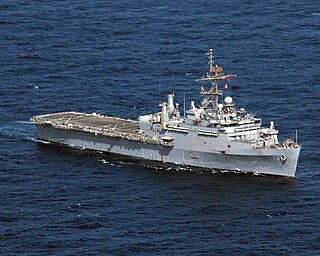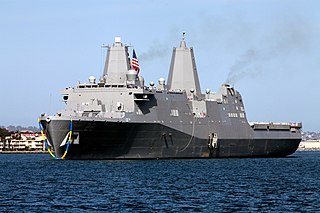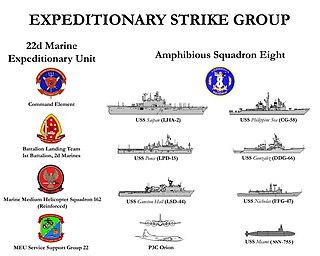
USS Tarawa (LHA-1), the lead ship of her class, is an amphibious assault ship that served in the United States Navy from 1976 to 2009. She is the second ship to be named for the Battle of Tarawa, fought during World War II. Tarawa was decommissioned on 31 March 2009, at San Diego Naval Base.

The San Antonio class is a class of amphibious transport docks, also called a "landing platform, dock" (LPD), used by the United States Navy. These warships replace the Austin-class LPDs, as well as the Newport-class tank landing ships, the Anchorage-class dock landing ships, and the Charleston-class amphibious cargo ships that have already been retired.

USS San Antonio (LPD-17), the lead ship of her class of amphibious transport dock or landing platform dock, is the first ship of the United States Navy to be named for the city of San Antonio, Texas.

USS New Orleans (LPD-18), a San Antonio-class amphibious transport dock, is the fourth commissioned ship of the United States Navy to be named after the city of New Orleans, Louisiana.

USS Nashville (LPD-13), an Austin-class amphibious transport dock, was the third ship of the United States Navy to be named for the capital city of Tennessee. Her keel was laid down on 14 March 1966 by the Lockheed Shipbuilding and Construction Company of Seattle, Washington. She was launched on 7 October 1967 sponsored by Mrs. Roy L. Johnson, and commissioned at Puget Sound Naval Shipyard, Bremerton, Washington, on 14 February 1970.

USS Ponce, is an Austin-class amphibious transport dock, formerly in service with the United States Navy. She has been the only ship of the Navy named for Ponce in the Commonwealth of Puerto Rico, which in turn was named after the Spanish explorer Juan Ponce de León, the first governor of Puerto Rico and the European discoverer of Florida. Her keel was laid down on 31 October 1966 by the Lockheed Shipbuilding and Construction Company of Seattle, Washington. She was launched on 20 May 1970 sponsored by Florence W. Hyland, the wife of Admiral John J. Hyland, and commissioned on 10 July 1971. She spent most of her career based on the East Coast and operating in the Atlantic Ocean and Mediterranean Sea, serving in Operation Desert Shield and supporting US operations in the 2011 Libyan Civil War.

USS San Diego (LPD-22), a San Antonio-class amphibious transport dock, is the fourth ship of the United States Navy to be named for San Diego, California.

USS Anchorage (LPD-23) is a San Antonio-class amphibious transport dock and the second ship of the United States Navy to be namesake of the U.S. city of Anchorage, Alaska.

USS Arlington (LPD-24), a San Antonio-class amphibious transport dock, is the third ship of the United States Navy to be named for Arlington, Virginia, the location of the Pentagon and the crash site of American Airlines Flight 77 during the terrorist attacks on 11 September 2001. Like her sister ships, USS New York and Somerset, she is named in commemoration of the attacks. Steel taken from the Pentagon after the attacks is displayed aboard in the ship's museum.

USS Somerset (LPD-25) is a San Antonio-class amphibious transport dock of the United States Navy. Somerset is the fourth Navy vessel, and the second warship to bear the name; the first two being a wooden-hulled motorboat and a ferry. The first warship, an armed cargo ship from World War II, was named for the Somerset Counties of Maine, Maryland, New Jersey and Pennsylvania collectively.

The Whidbey Island-class dock landing ship is a dock landing ship of the United States Navy. Introduced to fleet service in 1985, this class of ship features a large well deck for transporting United States Marine Corps (USMC) vehicles and a large flight deck for landing helicopters or V-22 Ospreys. The well deck was designed to hold four LCAC hovercraft, five if the vehicle ramp is raised, for landing Marines. Recent deployments have used a combination of LCU(s), AAVs, tanks, LARCs and other USMC vehicles. The Whidbey Island class of ship also uniquely benefits from multiple cranes and a shallow draft that further make it ideal for participating in amphibious operations.

The America class is a ship class of landing helicopter assault (LHA) type amphibious assault ships of the United States Navy (USN). The class is designed to put ashore a Marine Expeditionary Unit using helicopters and MV-22B Osprey V/STOL transport aircraft, supported by AV-8B Harrier II or F-35 Lightning II V/STOL aircraft and various attack helicopters. The first of these warships was commissioned by the U.S. Navy in 2014 to replace USS Peleliu of the Tarawa class; as many as eleven will be built. The design of the America class is based on that of USS Makin Island, the last ship of the Wasp class, but the "Flight 0" ships of the America class will not have well decks, and have smaller on-board hospitals to provide more space for aviation uses.
United States ship naming conventions for the U.S. Navy were established by congressional action at least as early as 1862. Title 13, section 1531, of the U.S. Code, enacted in that year, reads, in part,
The vessels of the Navy shall be named by the Secretary of the Navy under direction of the President according to the following rule: Sailing-vessels of the first class shall be named after the States of the Union, those of the second class after the rivers, those of the third class after the principal cities and towns and those of the fourth class as the President may direct.

In the United States Navy, the expeditionary strike group (ESG) is a coordinated group of surface ships, aircraft, submarines, and other naval assets. In contrast to carrier strike groups (CSGs), which emphasize air power and are led by a supercarrier, ESGs are strongly suited for amphibious warfare and are led by an amphibious assault ship. The ESG concept was introduced in the early 1990s, based on the Naval Expeditionary Task Force. The U.S. Navy fields nine expeditionary strike groups and ten carrier strike groups, in addition to surface action groups.

USS John P. Murtha (LPD-26) is the 10th San Antonio-class amphibious transport dock ship of the United States Navy, and is named in honor of Congressman John Murtha (1932–2010) of Pennsylvania. John P. Murtha is homeported at Naval Base San Diego.

HII Corporate, formerly Huntington Ingalls Industries, Inc., is the largest military shipbuilding company in the United States as well as a provider of professional services to partners in government and industry. HII, ranked No. 371 on the Fortune 500, was formed on 31 March 2011, as a spin-off of Northrop Grumman.
The procurement of Landing Platform Docks (LPD) by the Indian Navy, formerly known as the "Multi-Role Support Vessel Program" (MRSV) - is an initiative of the Indian Navy to procure a series of landing platform docks, specific vessels dedicated to amphibious warfare, as part of the service's strategy to augment its capabilities of amphibious warfare, disaster-response, humanitarian assistance and auxiliary duties.

USS Portland (LPD-27) is a San Antonio-class amphibious transport dock ship of the United States Navy, named after the U.S. city of Portland, Oregon.
The LX(R) class is a class of amphibious warfare ships under development for the United States Navy, to be contracted from 2020, as a replacement for the current Whidbey Island-class and Harpers Ferry-class dock landing ships.
























